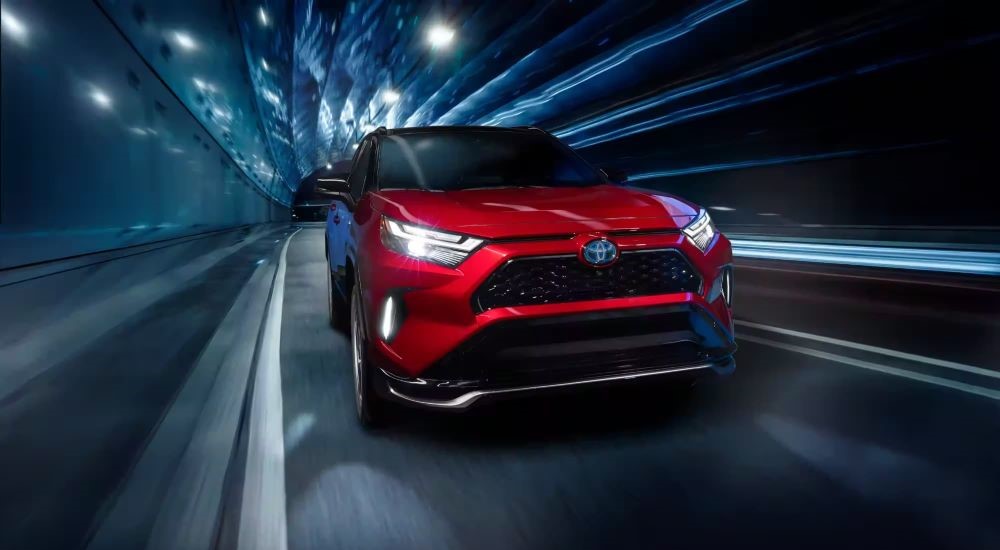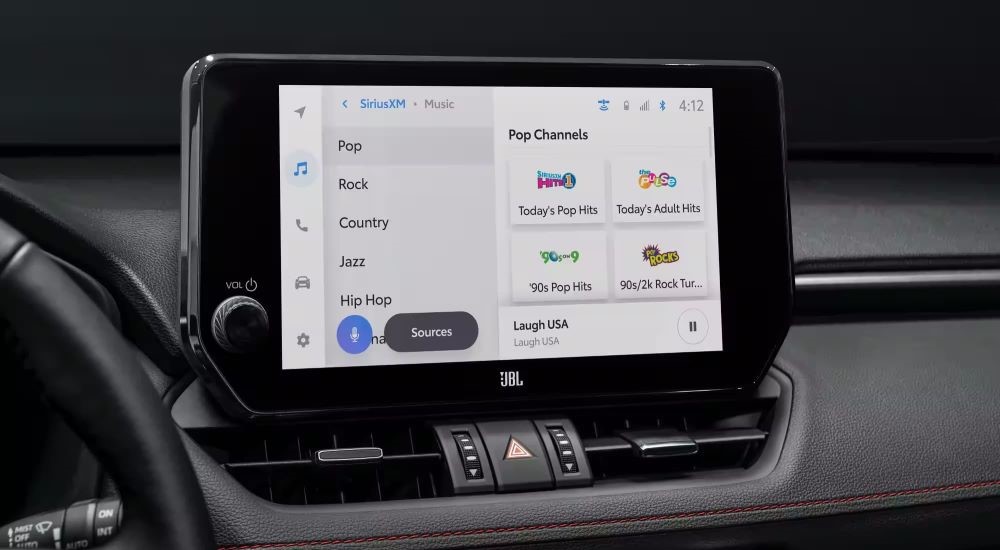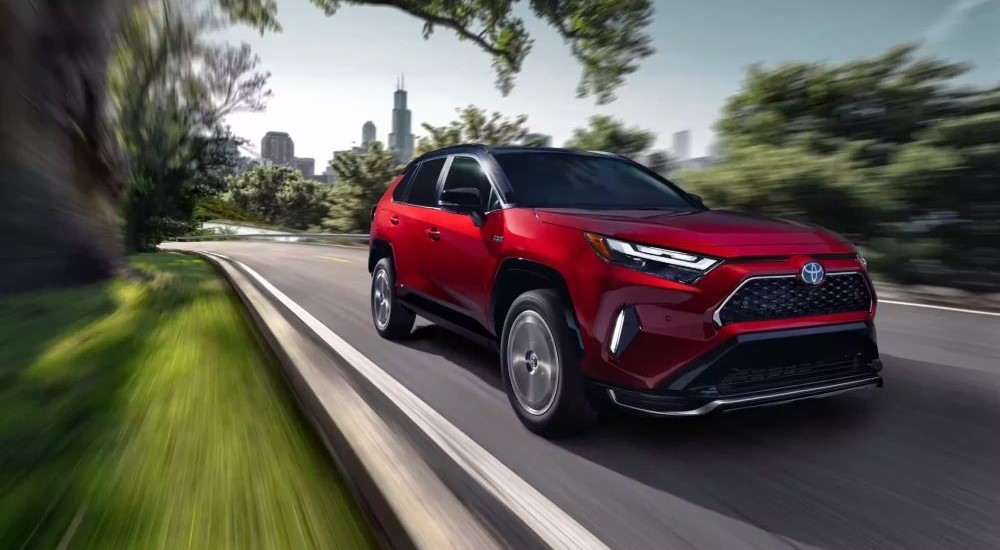When you hear the phrase “Toyota hybrid,” the iconic Prius may be the first model to pop into your head—but Toyota’s lineup is full of hybrids of all shapes and sizes, including several SUVs that are available with either traditional hybrid powertrains (where the battery is recharged through regenerative braking) and plug-in hybrid electric vehicles, AKA PHEVs (where the battery is recharged both by regenerative braking and plugging into an external power source). Telling the two types of hybrids apart is easy enough for Toyota vehicles, as their traditional hybrids have the word “Hybrid” at the end, and PHEVs have the word “Prime” instead. So the Grand Highlander Hybrid can’t get extra range from an EV charging station, but a Prius Prime can.
So when you see a Toyota RAV4 Prime for sale, one of the main things to consider is its fuel efficiency. PHEVs tend to have higher sticker prices than comparable gas-powered vehicles and traditional hybrids, so drivers understandably want to know what that extra money is getting them. If a little extra money upfront means big savings at the gas station over time, then you’re still getting a good value—but is the RAV4 Prime fuel-efficient enough to be worth it? And how does it compare to other eco-friendly Toyotas? Let’s dive in and find out what this electrified SUV has to offer…
Fuel Economy 101
Looking at fuel economy means sifting through a lot of numbers, so let’s start by providing a refresher on what those numbers mean. Fuel economy—also known as fuel efficiency—is measured in miles per gallon (MPG); as the name suggests, this figure lets you know how many miles your vehicle can travel on a gallon of fuel.
Electric power complicates this figure, so PHEVs and EVs use a figure called MPGe, which stands for “miles per gallon equivalent.” The exact mileage you get in such a vehicle can vary depending on factors like how much weight it’s carrying or towing, how flat or hilly the area is, how you drive, etcetera, so keep in mind that all MPGe figures are averages.
The EPA gives vehicles three fuel economy ratings: one for city driving, one for highway driving, and a city/highway combined average. This bureau also provides an estimated range for a vehicle, which lets you know how far you can expect to travel on a full tank of gas (or a fully charged battery). We’ll be looking at these official figures when comparing our vehicles.
According to the EPA, the average 2023 vehicle gets 28 MPG combined, so this is a good figure to keep in mind for routine comparison. Higher figures will save you money over time, and lower figures mean more pain at the pump.
Efficiency of the Non-Prime RAV4
To get an idea of how fuel-efficient the RAV4 Prime is, let’s get a baseline for what to expect from a vehicle of this size and type by looking at the other versions of the RAV4.
As you might expect, the non-hybrid RAV4 has the worst fuel economy of the bunch. However, even the least efficient 2023 RAV4, the TRD Off-Road trim, doesn’t dip below the fuel economy of the average 2023 vehicle, coming in at exactly 28 MPG city/highway combined. A non-TRD RAV4 with all-wheel drive gets 29 MPG city/highway combined, while a model with front-wheel drive is rated at 30 MPG and gives you 435 miles of range on a full tank.
Upgrade to the traditional hybrid powertrain, and you can get significantly better figures. Again, the rugged trim meant for off-road action gets the lowest rating, but at 37 MPG, the RAV4 Hybrid Woodland Edition is still a highly efficient vehicle. Outside of that trim, the RAV4 Hybrid is rated at 40 MPG, which is even more impressive when you consider that this model comes standard with all-wheel drive; that efficiency gives you 580 miles of range on a full tank, which is good news for road trippers.
The 2023 RAV4 Prime
If you never charge the battery of the 2023 RAV4 Prime, then it’s technically less efficient than the RAV4 Hybrid, getting a combined rating of 38 MPG. That’s still very efficient, but it doesn’t allow you to unlock the Prime’s full potential. With the battery fully charged, this SUV jumps all the way up to an unbelievable fuel economy rating of 94 MPGe, allowing you to save about $1,000 every year in fuel costs compared to the average new vehicle, according to the EPA.
With a full tank of gas and a fully charged battery, the RAV4 Prime has an average range of 600 miles. If you charge regularly, you can extend that range, which means fewer stops at the gas station. Since charging stations tend to be located in the parking lots of businesses, like at shopping centers, and you can likewise charge at home, refueling with a PHEV is more convenient and doesn’t require an extra stop like filling up at the gas station does.
If you have a short commute or tend to run errands close to home, you can take advantage of the RAV4 Prime’s all-electric range. In EV mode, this SUV can travel up to 42 miles at a time without using the engine at all; this means you can produce zero emissions while driving around town but will have the gas engine as a backup if you run out of range or if you want to take a longer road trip.
How Does It Compare to the Competition?
It makes sense that the RAV4 Prime is the most efficient version of the RAV4, but how does it stack up against other SUVs in its class? Let’s take a look at some popular compact SUVs from other automakers. The 2023 Honda CR-V isn’t offered as a PHEV, and its traditional hybrid version is rated at 37 MPG combined when paired with optional AWD, making it less efficient than the RAV4 Prime, even if you never charge the battery.
The Kia Sportage is offered as a plug-in hybrid but is 10 MPG less efficient than the RAV4 Prime with a fully-charged battery, with a rating of 84 MPGe, an all-electric range of 34 miles, and a total range of 430 miles. The Hyundai Tucson PHEV is slightly lower than that across the board, with 80 MPGe, 33 miles of range in EV mode, and a total range of 420 miles. Looking at these numbers, it’s easy to see why the RAV4 was the best-selling SUV in the US in 2022.
Final Thoughts on This Premier PHEV
Clearly, the RAV4 Prime has great fuel economy for its class. If you keep the battery charged, you have the potential to save heaps of money and reduce your pain at the pump. When you’re at home, you can plug the battery into a regular 120V outlet or get a 240V outlet installed for faster charging. With a 120V power source, the battery can be fully charged in 12 hours, which is slow but perfectly reasonable if you’re charging it overnight. With a 240V outlet, either at home or at a public charging station, the battery can be charged in as little as two and a half hours.
Once you find out where your local charging stations are and work them into your routine, recharging will become second nature. In fact, owning a PHEV can be a good transition vehicle if you’re hoping to drive an EV one day but aren’t sure if you’re ready to make that leap just yet. A PHEV like the RAV4 Prime lets you get acquainted with charging infrastructure but doesn’t rely on electricity alone for its power.
We’re not surprised to see plug-in hybrids gaining popularity in the modern automotive market, and we’ll be interested to see how this trend continues to play out in the years to come.






